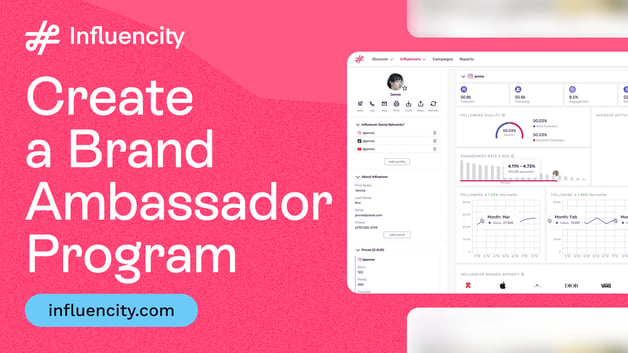Essential KPI Goals for a Successful Influencer Marketing Campaign
Influencer marketing can be a great strategy for connecting with your target consumers and swaying their purchase decisions. When executed properly, it can boost brand visibility, build consumer trust, and drive meaningful conversions. However, launching a successful influencer marketing campaign requires more than just selecting the right influencers; you also need to define clear KPI goals to measure the success of your efforts.
KPI goals provide measurable benchmarks that allow you to assess whether your campaign is achieving its intended objectives. But what exactly are KPIs, and why are they so important in influencer marketing?
In our latest post, we’ll explore the essential KPI goals you should be tracking to ensure your influencer marketing campaigns are a success. We will also share key strategies for setting realistic KPI targets, as well as guidance on how you can align your goals with your overall marketing objectives.
What Are KPIs?
Key Performance Indicators (KPIs) are measurable values used to evaluate the success of an organization, project, or campaign in achieving specific business objectives. They provide a way to track performance over time, offering insights into what's working and what needs improvement.
KPIs can be applied across various domains, from finance and operations to marketing and customer service. They vary depending on the nature of the goal they’re tied to. For example, in a business setting, KPIs might include revenue growth, customer retention, or operational efficiency. In the context of online marketing, KPIs usually include reach, engagement, conversions, and return on investment (ROI).
The purpose of KPIs is to provide clear, objective data that helps decision-makers understand where to focus their efforts. By tracking KPI goals, organizations can identify areas of strength, spot potential problems early, and make informed adjustments to improve outcomes. That way, efforts are aligned with long-term strategy and performance can be measured in a meaningful way.
Key Performance Indicators in Influencer Marketing
KPIs are essential when it comes to influencer marketing. They enable you to set clear goals for your campaigns and measure the impact of your collaborations.
Generally speaking, there are 4 key KPIs goals that you should be monitoring each time you launch a campaign: reach, engagement, conversions and ROI.
Let’s explore these essential influencer marketing metrics in a bit more detail.
Reach
Reach refers to the total number of unique people who have seen your content. It measures the size of the audience exposed to a post or campaign. In marketing, particularly on social media, reach gives an indication of how wide your message has spread, but it doesn't account for the depth of interaction (which is covered by engagement).
You can calculate this KPI goal for influencer marketing as follows:
Reach = Total Impressions / Frequency
Total Impressions refers to the number of times the content has been displayed (this includes multiple views by the same individual).
Frequency is the average number of times each unique individual has seen the content.
Example: f a campaign for a new product received 500,000 impressions with an average frequency of 2 views per person, your reach would be 250,000 unique individuals.
Engagement
Engagement measures the level of interaction that your content generates from your audience. It includes likes, shares, comments, clicks, retweets, and other forms of active involvement. A high engagement rate shows that the audience is not only seeing the content but is also interacting with it. Engagement is crucial for understanding how well your content resonates with your audience.
There are two crucial engagement metrics that you can use to calculate this:
Social Engagement Rate: This percentage indicates the level of interaction with an influencer’s posts relative to their follower count. A high engagement rate indicates a highly engaged audience.
Formula:
(Likes + Comments + Shares) / Follower Count x 100 = Social Engagement Rate
Example: If a post received 1,000 likes, 500 comments, and 300 shares, and the influencer has 50,000 followers, the social engagement rate would be 3.6%.
Engagements per Follower: This metric measures the average number of interactions per follower per post. This metric provides a more granular view of engagement strength.
Formula:
(Likes + Comments + Shares) / Follower Count = Engagements per Follower
Conversions
Conversions refer to the number of people who take a desired action after engaging with your content. This could be making a purchase, signing up for a newsletter, downloading an app, or completing any other objective you’ve set. Conversions are often seen as a critical indicator of marketing effectiveness as they align directly with business goals, such as increasing sales or lead generation.
You can calculate this KPI goal for influencer marketing as follows:
Conversion Rate = Number of Conversions / Total Clicks or Engagements x 100
The number of conversions refers to the total number of people who completed the desired action (e.g., made a purchase, signed up, downloaded an app).
Total clicks or engagements refers to the total number of people who interacted with the content, typically through clicks, swipes, or other forms of engagement.
Example: If 200 people made a purchase after clicking on an affiliate link from a post that generated 2,000 clicks, the conversion rate would be 10%.
ROI
Finally, influencer marketing ROI measures the profitability of an investment by comparing the returns (or benefits) from a campaign to its costs. It is typically expressed as a percentage and it is calculated with the following formula:
ROI = Net Profit / Investment Cost x 100
Essentially, influencer marketing ROI helps you assess how efficiently resources, such as budget and time, were used to generate a positive outcome, such as increased revenue or customer acquisition. High ROI indicates that a campaign is providing a good return for the money and effort invested.
Example: If a campaign generated $50,000 in profit from an investment of $10,000, the ROI would be 400%, indicating a highly successful campaign.
Strategies for Setting Realistic KPI Goals for Influencer Marketing Campaigns
We are going to finish today’s essential guide by sharing a few key strategies to help you set realistic KPI goals for your influencer marketing campaigns. We will also include a few examples so that you understand how you can align these KPI goals with your overall marketing objectives.
Align KPIs with Overall Business Objectives
The first step in setting realistic KPI goals for your influencer marketing campaigns is to ensure they are aligned with your broader business objectives. Whether your focus is on increasing brand awareness, driving website traffic, or generating conversions, your KPIs should reflect your overarching goals. By aligning with business priorities, you can make sure that influencer marketing contributes meaningfully to your company's growth.
For example, if your business objective is to increase brand awareness, your KPIs might include reach and impressions from influencer posts. If the goal is driving website traffic, you might opt for the click-through rate (CTR) on links shared by an influencer. If generating sales is your priority, you can track conversion rates and revenue generated from discount codes or affiliate links shared by an influencer.
Understand Your Audience and Platform
Different audiences and social media platforms require different approaches. Before setting KPI goals for your influencer marketing campaigns, consider the platform where the influencer is active and the type of audience they attract. Engagement rates and conversion expectations will vary between platforms like Instagram, YouTube, or TikTok, so be mindful of platform-specific behaviors and how your target audience interacts with influencers.
For example, if your influencer is active on Instagram, Instagram KPIs like story views, post saves, or comments might be more important, while on YouTube, watch time and video shares might be more relevant. Knowing how your target audience interacts on each platform will help you set KPIs that are tailored to your campaign's success.
Evaluate Influencer Performance Metrics
Before partnering with influencers, review their historical performance metrics, such as engagement rates, follower growth, and audience demographics. By understanding how an influencer's previous campaigns have performed, you can set more informed and achievable KPI goals for your influencer marketing campaigns.
For instance, if an influencer has a high engagement rate but a lower conversion rate, you might set engagement-focused KPIs, such as increasing likes, comments, and shares, rather than focusing purely on sales.
Set Benchmarks Based on Industry Standards
Research industry benchmarks and influencer marketing stats to set KPI goals that are competitive but realistic. Comparing your planned KPI goals to average influencer marketing metrics in your industry will give you a clearer sense of what is achievable.
For example, if industry data shows that influencers in your niche typically see an engagement rate of 5% and a conversion rate of 2%, you can use these as benchmarks for setting your own KPIs. You may aim for similar results or adjust based on the influencer’s past performance.
Consider the Campaign's Budget and Timeline
Finally, budget and time constraints play a significant role in setting realistic KPI goals for your marketing campaigns. A large budget may allow for more ambitious goals, while a smaller budget may require more modest targets. Similarly, campaigns with longer timelines may give you more flexibility to achieve growth, while short-term campaigns need metrics that reflect quicker, more immediate outcomes. That way, you can set KPI goals for your influencer marketing campaigns that are not only realistic but also drive meaningful results for your business.
Influencer Marketing KPI Goals: Key Takeaways
Setting and tracking the right KPI goals is crucial for the success of any influencer marketing campaign. These KPIs allow you to measure the effectiveness of your efforts and adjust strategies accordingly. Aligning these KPI goals with your broader marketing goals ensures that influencer marketing contributes meaningfully to your overall business objectives. Whether you're aiming to increase brand visibility or drive sales, clearly defined KPI goals provide a roadmap for success, ensuring your campaigns are both data-driven and results-oriented.
Tags:























%20and%20How%20Can%20They%20Benefit%20Your%20Brand%20article.jpg?length=628&name=What%20Are%20Key%20Opinion%20Leaders%20(KOL)%20and%20How%20Can%20They%20Benefit%20Your%20Brand%20article.jpg)








